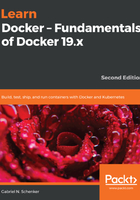
Conventions used
There are a number of text conventions used throughout this book.
CodeInText: Indicates code words in text, database table names, folder names, filenames, file extensions, pathnames, dummy URLs, user input, and Twitter handles. Here is an example: "The container runtime on a Docker host consists of containerd and runc."
A block of code is set as follows:
{
"name": "api",
"version": "1.0.0",
"description": "",
"main": "index.js",
"scripts": {
"test": "echo \"Error: no test specified\" && exit 1"
},
"author": "",
"license": "ISC"
}
When we wish to draw your attention to a particular part of a code block, the relevant lines or items are set in bold:
ARG BASE_IMAGE_VERSION=12.7-stretch
FROM node:${BASE_IMAGE_VERSION}
WORKDIR /app
COPY packages.json .
RUN npm install
COPY . .
CMD npm start
Any command-line input or output is written as follows:
$ /usr/bin/ruby -e "$(curl -fsSL https://raw.githubusercontent.com/Homebrew/install/master/install)"
Bold: Indicates a new term, an important word, or words that you see onscreen. For example, words in menus or dialog boxes appear in the text like this. Here is an example: "Select System info from the Administration panel."